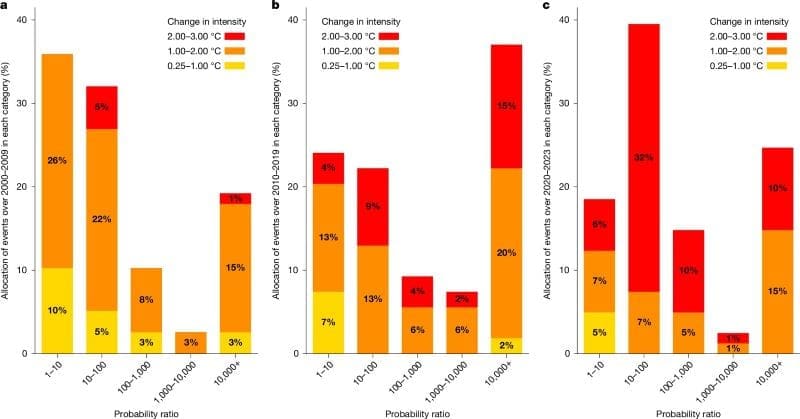In brief:
Summary:
Human-induced climate change has increased the frequency and intensity of global heatwaves, according to a new study published in Nature by Professor Sonia Seneviratne’s team at ETH Zurich. Examining 213 heatwaves reported worldwide between 2000 and 2023, the research demonstrates that warming since 1850–1900 has made these events significantly more likely. For example, heatwaves from 2000 to 2009 were roughly 20 times more likely due to climate change, while those from 2010 to 2019 became up to 200 times more likely.
The study also quantifies the role of the 180 largest producers of fossil fuels and cement, known as carbon majors, in driving these extremes. Emissions from these companies account for half of the observed increase in heatwave intensity since preindustrial times. For some major producers, their individual contributions were sufficient to make 16 to 53 heatwaves virtually impossible without human-driven climate change.
Lead author Yann Quilcaille highlights that even smaller carbon producers play a substantial role in heatwave occurrences. The research marks a significant advance in extreme event attribution, linking specific corporate actors to the worsening intensity and frequency of heatwaves. The findings provide a scientific basis for assessing corporate responsibility and could inform policy decisions and legal frameworks based on the “polluter pays” principle.

Rising heatwaves tied to fossil fuel and cement production
Last June, large parts of Europe experienced unprecedented heat. In July, the Mediterranean region groaned under the scorching heat, with locals and tourists suffering temperatures well above 40 °C (104 °F). In August, parched forests burned in many places. Around the world, a trend of record-breaking extreme heat is affecting our health and disrupting our economies.
The perception that current heatwaves exceed those of previous generations now has scientific backing, thanks to research led by ETH Zurich Professor, Sonia Seneviratne. The study documents how human-induced climate change has increased the frequency and severity of more than 200 heatwaves.
In their study, the research team looked at 213 heatwaves that occurred on all seven of Earth’s continents between 2000 and 2023. The study included all heatwaves that were reported by authorities or the media due to significant casualties, economic losses, or calls for international assistance. Africa and South America were significantly underrepresented in the study, however, due to underreporting and lack of usable data from these regions.
Climate change makes heatwaves more likely – and increasingly severe
Nevertheless, the trend is clear. “Climate change has made each of these heatwaves more likely and more intense, and the situation has worsened over time,” says lead author Yann Quilcaille, a postdoctoral researcher in Seneviratne’s research group. In terms of figures, this means that global warming made heatwaves 20 times more likely between 2000 and 2009, and as much as 200 times more likely between 2010 and 2019, compared with the period between 1850 and 1900.
Another aspect of the study considers who contributes to this trend. Researchers analysed the emissions that were facilitated by the 180 largest producers of fossil fuels and cement – referred to in the study as “carbon majors”. The emissions from these carbon majors account for 60 percent of humanity’s total cumulative CO₂ emissions from 1850 to 2023, with the rest of the CO₂ emissions largely attributable to land use activities. The researchers then calculated the contribution of each carbon major to the change in global average temperature.
The team also ran climate models excluding the emissions of individual carbon majors to highlight the effect of single players on the global average temperature. Once climate researchers know how much these companies have contributed to global warming and how this warming affects heatwaves, they can then calculate how much each of these carbon emitters has influenced each individual heatwave.
“For each heatwave, we calculate how climate change affected its intensity and likelihood,” Quilcaille explains. “We identify both the impact of each individual company and the combined effects of other human and natural factors.”
Even minor carbon emitters play a significant role
The researchers traced global warming’s contributions to heatwaves back to these 180 carbon-producing entities. Their calculations show that greenhouse gas emissions from these carbon majors have contributed significantly to climate change, causing heatwaves to become more likely and more intense. “About half of the change in global mean surface temperature in 2023 can be explained by the emissions of carbon majors,” says Quilcaille. Fourteen of the 180 entities stand out: they have made the same contribution to climate change as the remaining 166 organisations combined.
According to the study, the five largest producers of fossil fuels among state-owned entities or investor-owned companies are from the former Soviet Union, followed by the People’s Republic of China (due to coal production), and the oil and/or gas exporters: Saudi Aramco, Gazprom, and ExxonMobil.
“While the 14 largest carbon majors have contributed the most to the occurrence of heatwaves, the contributions of smaller players also play a significant role,” says Quilcaille. Even the CO₂ emissions of the smallest of the 180 carbon giants, the Russian coal producer, Elgaugol, are still enough to cause 16 heatwaves according to the calculations. The individual contributions of each one of the 14 largest players is enough to cause over 50 heatwaves that would have been almost impossible without climate change.
Energy transition delayed
Why are researchers calculating the contribution of fossil fuel and cement producers when every affluent person drives a car, flies in an airplane on vacation, or heats their home with oil; and, therefore, bears a collective responsibility for the heatwaves? “Past studies have mostly looked at emissions from people and countries. This time, we’re focusing on the big carbon emitters,” explains Quilcaille.
These companies have a particular responsibility, he says, as their business involves a very high carbon footprint, “These companies and corporations have also primarily pursued their economic interests, even though they have known since the 1980s that burning fossil fuels will lead to global warming.” According to Quilcaille, these entities have protected and continued their business activities through strategic disinformation and intense lobbying. “Even though every one of us – whether as individuals, countries, or companies – contributes to climate change, some actors have additional responsibilities,” says the researcher.
With this study, the research team aimed to fill a gap in scientific knowledge by using attribution studies to cover a wider range of extreme events and connect them to specific actors. However, their findings could also serve as a basis for establishing responsibility for increasingly frequent heatwaves and making the necessary adjustments to case law. The damage caused by heatwaves could also be assessed more strictly according to the “polluter pays” principle.
“We are now at the point where we recognise the serious consequences of extreme weather events for the world’s economies and societies – heat-related deaths, crop failures and much, much more. People are concerned about who contributed to these disasters,” says Quilcaille.
The researchers now want to systematically investigate other extreme events such as heavy rainfall, droughts, or fires to trace these events back to the contributions of individual actors, thus providing scientific information that can be used by decision-makers.
Contributions of individual actors rarely analysed
This kind of research is known as an attribution study. Climate scientists use these attributions to analyse and grade the relative contributions of different causes to climate change or specific events.
Until now, scientists studying extreme weather have mostly looked at one event at a time, with limited quantification of contributions from individual actors such as nations or corporations. This study by Professor Seneviratne and her research team marks the first time that multiple events have been systematically analysed together in this way.
Journal Reference:
Quilcaille, Y., Gudmundsson, L., Schumacher, D.L. et al., ‘Systematic attribution of heatwaves to the emissions of carbon majors’, Nature 645, 392–398 (2025). DOI: 10.1038/s41586-025-09450-9
Article Source:
Press Release/Material by Peter Rüegg | ETH Zurich
Featured image credit: Ganesh Ramsumair | Pexels




